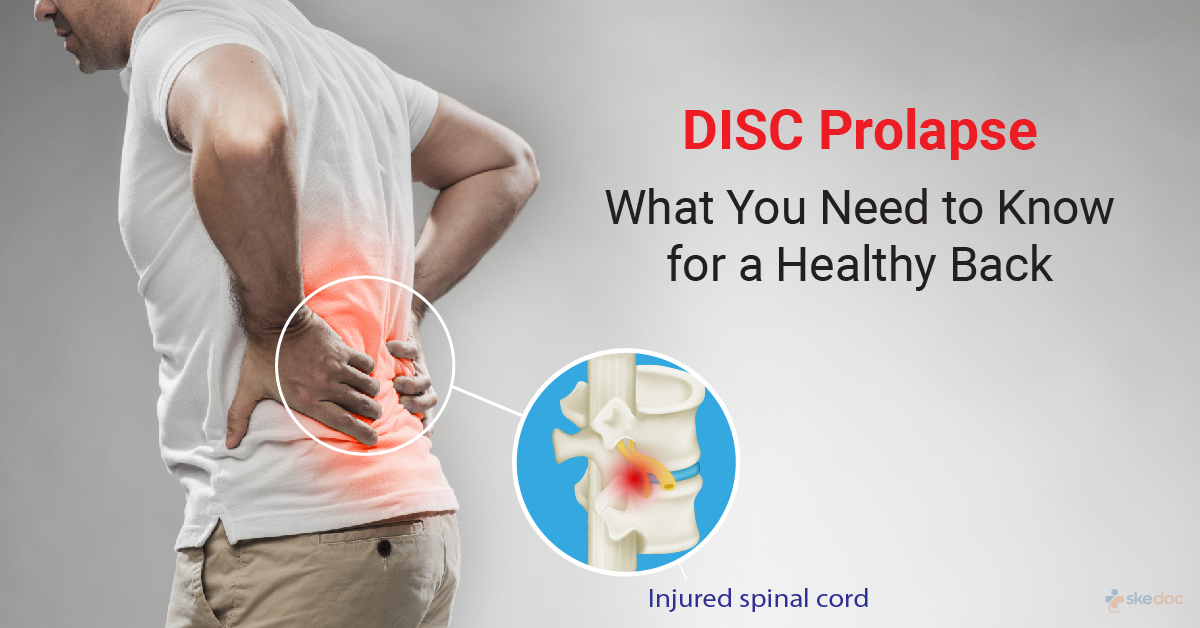Allergy
Blood Diseases
Bone & Joints
Brain
Cancer
Child Care
Cosmetic Surgery
Diabetes
Endocrinology
ENT
Eye
Gen Medicine
General Surgery
Heart
Kidney
Lifestyle
Liver & Digestive
Lung
Men’s Health
Mental health
Physiotherapy
Rheumatology
Skin and hair
Sleep Disorders
Spine
Transplant
Women Health
Thyroid
Vascular Surgery
Disc Prolapse

What is a Disc Prolapse?
Disc Prolapse is made up of small bones called vertebra. A disc is a strong rubber-like ligament that is present between each bony vertebra in the spine to act as a cushion and hold them together. A disc consists of a soft inner core surrounded by strong outer fibers.
Disc Prolapse is a medical condition when the outer fibres of the disc get ruptured, allowing the soft inner core to protrude out. The protruded or prolapsed disc compresses the spinal nerves, leading to various complications.
It can occur in any spine region, but mostly in the lower back region and neck region. The thoracic region is rarely affected. It can develop suddenly or gradually over weeks to months.
Alternate names
- Slipped disc
- Ruptured disc
- Herniated disc
- Prolapsed disc
- Herniated nucleus pulposus
Is disc prolapse a medical emergency?
Disc Prolapse is not a medical emergency.
Causes
Disc prolapse is caused by excessive pressure on the spine. A significant force on the spine can cause a vertebra to fracture or a disc to rupture. It occurs in the following cases:
- Falling from a significant height and landing on the buttocks
- Bending forward and trying to lift a heavy object
- Repetitive minor injuries to the spine that gradually weaken the outer fibres of the disc
- Damage to the disc due to advancing age or due to hereditary factors
- Damage to the disc while lifting an object and twisting or turning the body in a manner that puts pressure on the spine
Risk factors
Factors that increase the risk of developing a herniated disc are:
- Overweight
- Occupations that require repetitive heavy lifting, pulling, bending, pushing, and twisting
- Family history of Disc Prolapse
- Tobacco smoking lessens the oxygen supply to the disc, causing it to become weak.
- Anatomical abnormalities
- Participating in high-impact sports
Signs & symptoms
Signs and symptoms of a herniated disc depend upon the location of the disc prolapse and the severity of the condition. Symptoms appear on the body parts that are served by the affected nerve.
They include:
- Pain runs down the arms and legs on either one or both sides
- Pain in the shoulder blades if disc prolapse occurs in the cervical region
- Pain in the buttocks if disc prolapse occurs in the lumbar region
- Numbness, tingling, pins and needle sensation in one or both the arms and legs
- Muscle weakness and decreased range of motion in one or both the arms and legs
- In severe cases, there may be bladder and bowel incontinence and numbness in the genital area
Investigations
Investigation tests that are performed to rule out the herniated disc are:
- A physical examination that includes reviewing problems with walking, problems with bowel or bladder emptying, history of falls or injury, and symptoms of numbness and weakness
- Neurological examination to check muscle strength, reflexes, and sensation to light touch, pinpricks, and vibration
- Radiological tests like x-rays and CT scans to determine infection, tumor, and fractures.
- Magnetic Resonance Imaging (MRI): This is the most accurate test to determine herniated disc
- Myelogram to determine the pressure on the spinal cord and nerves due to herniated disc or other conditions
- Nerve conduction study to identify the nerve that is responsible for the symptoms
- Electromyography measures electrical impulses along with the nerve roots and muscle tissues
Diagnosis
The diagnosis of disc prolapse is made based on the findings of the physical examination, neurological examination, and the results of the investigations done.
Treatment options
In a majority of the cases, Disc Prolapse resolves on its own without treatment in 6 to 8 weeks or a bit longer. If any spinal cord compression or nerve root compression is identified, options for treatment for a herniated disc include the following:
Medical Treatment
Medical treatment for herniated discs includes:
- Pain medications and opioids
- Muscle relaxers
- Corticosteroid injections
Interventional treatment including surgery and indications for surgery/ Surgical treatment
Discectomy: Surgery is recommended for the failure of conservative treatment. It includes:
- Removing the protruded portion of the disc
- Rarely removing the entire disc
After the protruded portion of the disc is removed, the vertebrae are fused with a bone graft.
Physical therapy: Disc Prolapse is supplemented with physical therapy, which includes exercises to reduce pain, muscle stiffness, and muscle spasms and to improve muscle strength and flexibility.
Role of Diet/ Exercise/ Lifestyle changes/ Preventive measures
The treatment of herniated discs includes:
- Apply heat or cold compresses to relieve pain and inflammation
- Practice gentle exercises to improve spine mobility
- Avoid spending a prolonged time on the bed. Staying in bed for long hours makes the joints stiff
Preventive measures for herniated discs are:
- Avoid strenuous activities that can put pressure on the spine
- Maintain adequate weight
- Avoid risky and hazardous activities to prevent falls and injuries
- Sit and stand in proper posture
Complications
Disc Prolapse can cause the following complications:
- Disc Prolapse can put direct pressure on the spinal nerves or spinal cord
- The prolapsed disc touches the nerves and causes irritation of the nerve roots, which can lead to inflammation of the nerves
- Disc Prolapse can cause weakness and numbness in the arms and legs that hamper daily activities
- Disc Prolapse also causes bladder and bowel dysfunction
Prognosis
The overall prognosis of the herniated disc is excellent. A majority of 80% to 90% of the cases completely resolve within a few weeks with conservative treatment and restricted activity.
When to contact the doctor? / How to identify the complications?
A medical consultation is recommended to observe any neck or back pain that radiates down the arms or legs and is associated with weakness, numbness, and tingling sensation.
Indications for hospitalization if required
Disc Prolapse generally does not require hospitalization. However, when surgical treatment is recommended in the treatment of herniated disc, hospitalization is warranted. The length of the hospital stay depends upon the medical condition of the individual.
Suggested clinical specialists/ Departments to consult for this condition
- Neurosurgery
- Orthopedic surgery
Was this article helpful?
YesNo




